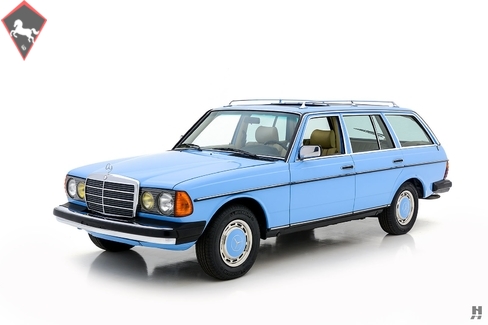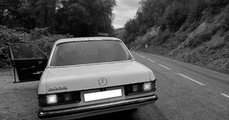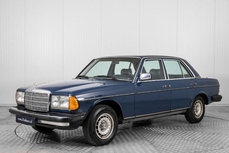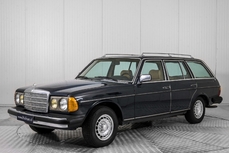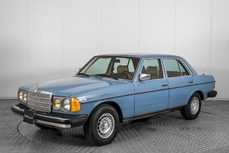Mercedes-Benz 300D w123 Station Wagon 1983
Allgemeine Beschreibung :
The Mercedes-Benz W123 succeeded the W114 in 1975, taking over the role of mid-sized volume-sales leader. The fresh, modern styling by Friedrich Geiger and Bruno Sacco was a hit with buyers, who waited up to a year to get their hands on one from the moment production commenced. Demand was so strong that some customers resorted to buying gently used examples for several thousand Deutschmarks above the original sale price to avoid the long backlog from the factory. Part of the delay was that Mercedes-Benz gradually increased production to ensure strict quality control, but the W123’s popularity meant that the waiting list lasted clear through to the end of production in 1986. While Mercedes buyers of today pay for the latest technology and technical wizardry, the W123’s premium price reflected its almost obsessive levels of quality and refinement. Over-engineered, meticulously built, and extremely durable, the W123 found favor with everyone from families, to executives, to heads of state. Base models served as taxis on nearly every continent and are still on duty, particularly in places where the car’s ability to handle the harshest environments is necessary. Professional drivers so loved the W123 that when its replacement, the W124, arrived in 1985, German taxi drivers took to the streets to protest the perceived drop in quality!
Between 1976 and 1986, Mercedes-Benz produced nearly three million examples of the W123 chassis, firmly establishing it as the best-selling Mercedes to date. Along with the sedan, the lineup also included a stylish 2-door GT coupe, long-wheelbase limousine, a chassis variant, and a handsome four-door estate. The four-door sedan made up the overwhelming bulk of production, numbering over 2.3 million, with the next closest being the wagon at just under 200,000. Petrol options started with a 2-liter inline-four, going up to a 2.8-liter twin-cam inline-six. Diesel engines were the popular choice, beginning with a humble 2-liter, 55 hp four-cylinder at the base, up to the superb OM617: A sophisticated 125 horsepower 3-liter Turbodiesel inline-five, which made light work of the hefty W123 body. Thanks to their superior economy and near bomb-proof reliability, diesel engines made up the vast majority of production. The W123 is indeed a car for every occasion, built to withstand the harshest conditions, yet remain solid, smooth, and exceptionally comfortable. Equally at home in the Sahara Desert as it is rolling up to gates of the country club, this legendary Mercedes-Benz could handle any task with understated Teutonic grace.
This highly desirable 1983 300TD Turbodiesel wagon is a splendid example, cherished since new and treated to a comprehensive restoration carried out between 2015 and 2018. This marvelous W123 was delivered new in Oklahoma City, OK, in January 1983. It would soon find its way to Houston, Texas, where it lived the majority of its life. The wagon was one of the more expensive models in the regular lineup, and most came very well equipped. This car is no exception, featuring Bosch fog lamps, power windows, sunroof, Becker AM/FM cassette stereo, automatic antenna, cruise control, tinted glass, and roof rails. In the care of several long term owners, the most recent caretaker acquired it in 2012 and commissioned its restoration shortly after.
Perhaps because of their near-bulletproof reliability and exceptional longevity, we rarely encounter W123s so beautifully and comprehensively restored. This superb wagon received an engine-out, glass-out, interior-out repaint in the period-correct shade of China Blue. The color choice suits the station wagon particularly well, and thoughtful additions like the factory steel wheels with iconic color-keyed wheel covers accentuate the car’s timeless, classic appeal. The paint quality and the overall attention to detail are superb, with fittings such as the anodized body trim, chrome bumpers, black rubber bumper extensions, lights, and lenses all presenting in outstanding condition.
While the body underwent its restoration, the interior received a full re-trim using correct Mercedes-Benz materials. Cream leather (code 455) replaced the original MB-Tex on the front and rear seats, and the headlining and correct-style carpeting is all new. The upholstery work alone totaled nearly $15,000, reflecting the owner’s commitment to having the best W123 this side of Stuttgart. The original instruments and switchgear are in good order, and the factory Becker cassette deck still sits in the dash. In the interest of efficiency and reliability, restorers updated the original air conditioning system with new, modern-style components from Vintage Air. The work included a new compressor, condenser, electric fan, fan clutch, and subtly integrated controls in the center console. Extras include the original tool kit, period-accessory sisal floor mats, and a pair of vintage American Tourister suitcases.
In its day, the OM617 turbodiesel, as fitted to this 300TD, was renowned for its smoothness and refinement. Arguably one of the most significant passenger car engines produced by Mercedes-Benz, the OM617 revolutionized the use of diesel power in luxury automobiles. The engine and transmission in this car are the original, numbers-matching units per the data card. Under-hood presentation is tidy and clean, showing some light signs of use since the restoration, but is otherwise well-detailed with correct painted and cast surfaces, and yellow zinc-plated fuel lines and hardware. It runs beautifully, as it should, with smooth shifts from the automatic gearbox and the signature 5-cylinder soundtrack.
Few cars in history match the Mercedes-Benz W123’s combination of versatility, dependability, and timeless design. This highly desirable wagon exudes charm, with a level of restoration rarely seen on similar examples. Practical, reliable, and fun to drive, this superb 300TD is the ideal family-friendly classic, and a fantastic choice for Cars & Coffee, Radwood, or just for taking the whole family out for ice cream on a summer evening.
Offers welcome and trades considered
https://hymanltd.com/vehicles/6630
1983 Mercedes-Benz 300D w123 Station Wagon is listed verkauft on ClassicDigest in St. Louis by Mark Hyman for $47500.
Fakten der Auto
Karosserietyp : Auto Marke : Mercedes-Benz Modell : 300D w123 Ausführung : Station Wagon Hubraum : 0.0 Modelljahr : 1983 Karosstyp : Kombi Lage : Missouri
Verkauft
Angaben Zum Verkäufer
Verkauft
People who viewed this Mercedes-Benz 300D w123 also viewed similar Mercedes-Benz listed at ClassicDigest
Other cars listed for sale by this dealer
über Mercedes-Benz
In den Annalen der Automobilgeschichte entfaltet sich die Reise von Mercedes-Benz wie eine Erzählung voller Ingeniosität seiner Gründer. Im Jahr 1886 schuf Karl Benz den Benz Patent Motorwagen, eine Kreation, die als das weltweit erste Automobil in die Geschichte eingehen sollte. Unwissentlich markierte dieser Moment den Ursprung dessen, was sich zu einem weltweit renommierten Premium-Autohersteller entwickeln würde. Die finanzielle Basis dieses bahnbrechenden Unternehmens wurde interessanterweise von Karls Ehefrau, Bertha Benz, bereitgestellt, was eine bemerkenswerte Partnerschaft demonstrierte, die den Ton für das Erbe von Mercedes-Benz setzen sollte.Nicht weit entfernt entstand eine parallele Erzählung, als die Daimler-Motoren-Gesellschaft, gegründet von Gottlieb Daimler und Wilhelm Maybach, die Bühne betrat. Im Jahr 1901 enthüllten sie ihr Auto unter dem mittlerweile berühmten Namen "Mercedes", was auf Spanisch "Geschenk Gottes" bedeutet. Dieser Name wurde auf das Auto auf Wunsch von Emil Jellineks Tochter verliehen, dem Vertriebspartner der Daimler-Motoren-Gesellschaft. Die Räder der Innovation wurden in Bewegung gesetzt.
Springen wir vorwärts ins Jahr 1926, ein entscheidendes Jahr, das die Fusion von Daimler mit Benz & Cie. sah, was zur Geburt von Daimler-Benz führte. Die Fusion führte zur Übernahme von "Mercedes-Benz" als das renommierte Markenzeichen für ihre Automobile und verschmolz die Legenden zweier visionärer Unternehmen zu einer.
Entgegen konservativen Wahrnehmungen entfaltet sich die Geschichte von Daimler-Benz als Chronik von Branchenneuheiten. Von der Einführung des Wabenkühlers über den Schwimmervergaser bis zur bahnbrechenden Einführung von Vierradbremsen im Jahr 1924 trieb Daimler-Benz kontinuierlich die Grenzen der automobilen Innovation voran. Der Dieselantrieb des Mercedes-Benz 260 D im Jahr 1936 markierte den Beginn von Dieselmotoren in Personenkraftwagen. Der ikonische Mercedes-Benz 300SL Gullwing schrieb Geschichte als das erste Auto mit direkter Kraftstoffeinspritzung, wenn auch der winzige 2-Takt-Motor des Gutbrod Vorrang beanspruchen kann.
Sicherheitsinnovationen wurden zum Markenzeichen, mit Béla Barényis patentiertem Sicherheitszellen-Design in den "Ponton"-Modellen im Jahr 1951, das Front- und Heck-Knautschzonen umfasste. Der W116 450SEL 6.9 führte die Einführung des Antiblockiersystems (ABS) ein, eine weitere wegweisende Sicherheitsfunktion. Vom ersten serienmäßigen Airbag bis hin zu vielen weiteren Innovationen wurde das Erbe der "Ersten" weiter in das Gewebe von Daimler-Benz eingeschrieben.
Auf seiner über hundertjährigen Reise hat Mercedes-Benz nicht nur Autos produziert, sondern automobile Ikonen geschaffen. Der SSKL, 710 SSK Trossi Roadster, 770K Grosser, 540K Spezial Roadster, 300SL Gullwing, W100 600 Pullman, W111 280SE 3.5 Flachkühler, W113 230SL Pagode, W109 300 SEL 6.3 und W201 2.3-16 Cosworth sind Zeugnisse des Engagements der Marke für Ingenieurkunst.
Die donnernden Silberpfeile, oder "Silberpfeile", darunter der W 25, W 125, W154, W165 und W196, schufen ein Erbe der Dominanz auf der Rennstrecke. Diese Maschinen waren nicht nur Autos; sie waren Ausdruck von Präzision, Geschwindigkeit und einem unbezwingbaren Geist, der die Konkurrenz im Staub zurückließ.
Während Mercedes-Benz in die Zukunft schreitet, tut es dies nicht nur als Automobilhersteller, sondern als Hüter eines Erbes, als Fackelträger der Innovation und als Leuchtturm automobiler Exzellenz. Der Weg in die Zukunft wird zweifellos die Fortsetzung der Verschmelzung von modernster Technologie, zeitlosem Design und dem unerschütterlichen Engagement für die Festlegung neuer Standards in der Welt der Automobile erleben.
